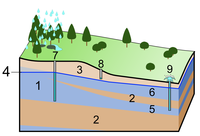
Photo from wikipedia
During drought, groundwater is often relied on to provide secure drinking water, particularly in rural Africa where other options are limited. However, the technology chosen to access groundwater significantly affects… Click to show full abstract
During drought, groundwater is often relied on to provide secure drinking water, particularly in rural Africa where other options are limited. However, the technology chosen to access groundwater significantly affects local water security. Here we examine the performance of springs, hand-dug-wells and boreholes in northern Ethiopia through direct high frequency monitoring of water-levels (n=19) and water quality (n=48) over an 18-month period and gathering information on community impacts of declining water access during the El Nino 2015/2016 drought. We found that shallow boreholes equipped with handpumps were the most reliable water supply, recovering within hours to daily abstraction throughout all conditions. Recovery and performance of most hand-dug-wells and springs declined significantly throughout the extended dry season, although in specific aquifer conditions they were reliable. All sources types had negligible measured contamination from Thermo-tolerant Coliforms through the extended dry season, but were contaminated during the rains marking drought cessation. Boreholes were least affected, median 10 cfu/100ml, compared to 190 and 59 cfu/100ml for hand-dug-wells and springs respectively. Many communities who relied solely on springs, wells or rivers experienced severe water shortage in the El Nino drought with mean daily collection times up to 12 hours and volumes collected reducing to 3-5 litres- per-capita-per-day. This led to reports of violent conflict, missed meals, reduction in school attendance and farm activity and increased health impacts. From this study there is a clear case for improving resilience to drought by installing boreholes equipped with handpumps where feasible even if collection times are agt;30 minutes.
Journal Title: Environmental Research Letters
Year Published: 2019
Link to full text (if available)
Share on Social Media: Sign Up to like & get
recommendations!